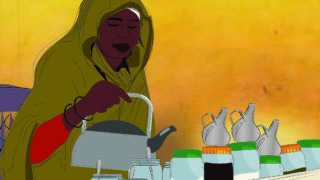
This publication has benefited from the support of the Rosa Luxemburg Foundation. This text may be reproduced in part or in full, provided the source is acknowledged.
The world has been facing climate change with two methods: mitigation, which is a direct measure to reduce emissions, and adaptation, which strengthens resilience in the face of climate effects, requiring extensive efforts to eventually mitigate the destructive damages. Being the most affected by climate change implications, developing countries inevitably resort to “adaptation” options.
Chronic environmental questions and a declining development
During COP27, held in Sharm el-Sheikh city, the Egyptian president announced the launch of the Sharm el-Sheikh Adaptation Agenda, in an attempt to rally global efforts to address the gaps in adaptation. The agenda operates through six measures that target a climate resilient and sustainable agriculture, which could increase yields by 17% and reduce farm level greenhouse gas emissions by 21%. The agenda also aims to protect and restore around 400 million hectares in critical territories in order to support local and indigenous communities with the use of nature-based solutions to improve water security and protect 3 billion people by setting up smart and early warning systems. The agenda aims to invest USD 4 billion to secure the future of 15 million hectares of mangroves, which resist the elements that cause coastal erosion and store carbon at a rate 5 times greater than that of a rainforest. The agenda also proposes projects to expand access to clean cooking for 2.4 billion people. (1)
Climate Change: It’s About Time!
29-12-2022
Sudan, with its population of 44.91 million people, is one of the developing countries most vulnerable to climate change. It is overburdened with limited economic development and growing environmental problems and is faced by a complex challenge. To begin with, it is necessary for the country to repair and restore that which it currently has in order to be able to absorb the new projects which aim to tackle the climate crisis. While some small developmental achievements were realized in recent years, they lack continuity. Likewise, lack of policies, plans, and agendas have been clearly reflected in the shares of development in consecutive state budgets for more than 20 years. Furthermore, the infestation of a multi-headed corruption weakened state authority over public money, and the emergence of parallel economies have all exhausted national economy.
Such conditions have resulted in a decline in development and the corrosion of the little existing development. This has led to extensive migrations from rural to urban areas, which, in turn, placed massive pressure on (the already limited) services and infrastructures in cities.
Although Sudan continued to implement the IMF and World Bank policies, which instruct the state to stop subsidizing fuel, wheat, and medicine, and to liberalize the exchange rate, none of that was reflected in the production sectors, which have also been weakened as a result of the lack of planning. Everybody thus drowned in a turmoil of political conflict and the horrific powerlessness before the rampant corruption in all sectors as, according to the Index of Transparency, Sudan remains at the top of the most corrupt countries, ranking 164 out of 180 countries. The value of the Sudanese pound plummeted (2) in recent years, as it lost around 87% of its purchasing power to the dollar between 2019 and 2021.
As state presence is lagging, which has become a prominent characteristic in Sudan, environmental problems increase: deforestation, overgrazing, soil erosion, and desertification… These have all led to a declining agricultural production, which, in turn, results in a decline in local food production. Furthermore, recent governments’ policies have stepped up their levies in order to cover the deficit in budgets. Traditional gold mining has also been on the rise, forcing some rural communities to transform agricultural lands into working areas for grinding mills, which degrades the soil in the long run. Notably, agriculture and animal husbandry are considered main economic resources for the majority of the Sudanese population.
Data indicates that Sudan has lost massive areas of agricultural and rangelands to desertification and has lost land productivity in rainy regions. Rainfed lands are considered the main source of food security, as production dropped from around 600-700 kg/feddan in the 1960s to 100-120 kg/feddan at present.
Climate Change: What Will Happen in Sudan?
14-12-2022
Desertification directly impacts the environment and local economies, including losing crops and livestock production, a decline in the absorptive capacity for animal grazing, a drop in underground water reserves, and wildlife loss. The effects of desertification are manifest in both North Kordofan and North Darfur states, where sands constantly move into productive soils, with the total length of the Nile shortened as sand dunes intensively encroach on it. Likewise, desertification is considered one of the longest standing blatant environmental issues in Sudan.
Despite some humble developmental achievements that Sudan has realised in recent years, lack of policies, plans, and agendas have been clearly reflected in the shares of development in consecutive state budgets – for more than 20 years. Furthermore, the infestation of a multi-headed corruption, weakened state authority over public money, and the emergence of parallel economies have all exhausted national economy.
Sudan continued to implement the IMF and World Bank policies, which instruct the state to stop subsidizing fuel, wheat, and medicine, and to liberalize the exchange rate. However, none of that was reflected in the production sectors, which have also been weakened by the lack of plans, political conflict, and the horrific powerlessness before the rampant corruption. According to the Index of Transparency, Sudan remains at the top of the most corrupt countries, ranking 164 out of 180 countries.
Following the separation of South Sudan, Sudan’s forest cover shrunk from 29.4% to 11.6%, by which Sudan became one of the scarce forest cover regions. As deforestation rates rose from 0.74% to 2.46%, Sudan became ranked first in deforestation globally.
What’s to be done?
The National Adaptation Plan (2016) (3), which covered all of Sudan’s regions, recommended that several measures be implemented in agriculture, rangelands, and water. The plan recommended that measures focus on conducting studies to improve water management around the most vulnerable areas. More wells and boreholes needed to be dug in areas that are safe from pollution, more efficient irrigation systems should be introduced, while the rehabilitation of water basins and dams would improve water access. Regarding rangelands, the plan recommended that adaptation measures for rangelands should include building awareness in local communities regarding sustainable natural resource management, the enforcement of existing legislation, the introduction of legislative reforms to better ensure the protection of the natural resource base, the launching of special programs targeting pastoralists for improving livestock genetic resources and productivity, improved agriculture extension programmes, and strengthening institutional capacity to create and implement land policy that encourages effective agriculture. This would necessarily require the revision of property right laws and the development of new land dispute mechanisms, as land plays a pivotal role in conflicts and fighting among local communities.
70% of the population in Sudan relies on natural resources, namely agriculture and livestock, to earn a living. As such, State plans to face climate change revolve around implementing adaptation projects in these sectors, especially since Sudan is one of the most drought susceptible countries in Africa. The drylands are considered home to nearly two thirds of the population, while more than 60% of the population lives in rural areas. According to the Three-Year Programme for Stability and Economic Development (2021-2023), Sudan is one of the countries with the highest rates of population growth (2.6% annually), which indicates a large demand for basic services, especially those related to healthcare, education, and water. Since the 1990s, Sudan has begun to implement environmental projects that are closely tied with climate change. According to the Higher Council for the Environment and Natural Resources, Sudan has implemented 34 projects between 1996 and 2022, including the Convention for the Protection of the Ozone Layer, the National Adaptation Plan to adapt to climate change and adapt rural livelihoods to climate change.(4)
Currently, a number of projects that target the capacity building of concerned institutions or the natural resource improvement in agroforestry, gum Arabic, grazelands, and water. When it comes to mitigation projects, those are considered limited in comparison with adaptation projects, because the emissions produced by Sudan and most developing countries is negligible in comparison with major industrialized powers. For example, 17 projects that target emission reduction are being implemented, some of which are under implementation while some are yet to be implemented. They have started gradually, since 2010, with solar power facilities, especially in agricultural projects, to reduce greenhouse gas emissions. They support adopting solar photovoltaic technologies to pump irrigation water in agriculture, especially in the northern state; likewise, they aim to help Sudanese farmers reduce their reliance on fossil fuel and reduce their production costs (by trimming off diesel costs), increase water use sustainability, and increase their income. Some other projects also aim to strengthen wind energy and operate water pumps with solar power, while a number of others are mitigation projects.
Building resilience within agriculture and pastoralism
The “Building resilience in the face of climate change within traditional rain fed agricultural and pastoral systems” is considered one of the biggest adaptation projects currently implemented by the Green Climate Fund (5), with USD 25.6 million in financing and USD 540 thousand from the United Nations Development Programme, with USD 15 million that the Sudan government must commit to co-finance.
The five-year project (2020-2024) covers 138 villages in nine states: East Darfur, West Darfur, Central Darfur, West Kordofan, South Kordofan, Kessala, the Red Sea State, the Northern State, and Khartoum. It aims to improve resilience in food production systems in communities suffering from food insecurity. Around 200 thousand families, farmers, and pastoralists benefit from the project, with 35% of it set aside for women. The project also outlines ways to improve water resource access for humans and animals.
Data indicates that Sudan has lost massive areas of agricultural and rangelands to desertification and has lost land productivity in rainy regions. Rainfed lands are considered the main source of food security, as production dropped from around 600-700 kg/feddan in the 1960s to 100-120 kg/feddan at present.
70% of the population in Sudan relies on natural resources, namely agriculture and livestock, to earn a living. As such, State plans to face climate change revolve around implementing adaptation projects in these sectors, especially since Sudan is one of the most drought susceptible countries in Africa.
Adel Mohammed Ali (6), the project evaluation and monitoring official, says that 70% of the project has been completed in agriculture, and that improved drought resistant fast ripening seeds have been introduced into a number of states. According to the Ali, this has led to doubling the production, alongside adopting safe storage systems. In pastoralism, 6500 hectares of land have been rehabilitated, while a number of communal forests, farmlands, and women-run nurseries have been installed.
As regards water, however, no more than 40% of the plan has been completed. The project official blames it on the nature of water resources and the technical issues related to them, in addition to an increase in costs. He also points out some issues that are related to a few local communities refusing to install new wells, as those would turn the area into grazelands.
The official lists some challenges that the project faces, including Sudan’s government failure to observe its financial obligations; while it must pay USD 15 million for this project, up till today, it has only paid USD 30 thousand. He says that there are administrative and regulatory challenges related to financial measures and procurement and contractual regulations at the Ministry of Justice, which is the official body in charge of governmental contracts, alongside internal issues related to the Council of the Environment.
The challenges facing this project are a microcosm of the challenges that face Sudan in terms of climate change. They reflect political will in general, which is the biggest of those challenges, where a considerable amount of legislative work is required in order to reform the land laws. In Sudan, land is considered a key communal question.
As no government has been formed since the military General coup in October 2021, Sudan has yet to submit Third National Communication Report, which is a biennial update report that must be prepared and submitted to the United Nations Climate Change secretariat. The report, however, has yet to be approved.
Besides “building resilience”, the Green Climate Fund has been funding, since 2019, a gum Arabic project, which aims to strengthen the adaptive capacity of local communities and rehabilitating the carbon sink in the gum Arabic belt in the Kordofan states, where it is being restored. Gum is normally farmed alongside annual food crops in order to increase their yield – as it fertilizes the soil, improves water infiltration, and reduces evaporation by reducing wind speed. According to the Green Climate Fund, climate change has been affecting gum Arabic yields in Sudan due to moisture stress, reaching 50% a year.
The project, “Building resilience in the face of climate change within traditional rain fed agricultural and pastoral systems,” and the challenges it faces are a microcosm of the challenges facing Sudan when it comes to climate change. These issues may generally be blamed on a weakened political will.
The project works on elevating climate resilience for living and ecological, agricultural, and pastoral systems in the Kordofan states, with lowering greenhouse gas emissions from land use by 9.23 million tonnes of CO2. The project invests in livestock mobility and restoring rangelands back to 275 thousand hectares of land.
The fund also finances a joint African project for 13 of the countries most affected by climate change in Africa. It aims to implement the Great Green Wall initiative to reverse land degradation. This program covers 11 countries in the Great Green Wall, in addition to Côte d’Ivoire and Ghana. The initiative’s main goal lies in building more consistency and integration in climate work among these countries. The total financing of the projects funded by the Green Climate Fund for Sudan is USD 43 million (7).
According to Dr Omer Ajemi, professor of political ecology at the University of Khartoum, Sudan - despite this number of projects - isn’t ready to address the question of climate change (8). Ajemi blamed this on structural impediments, starting with chronic poverty, which the majority of the Sudanese suffer from. In his view, chronic poverty goes deeper than the climate change question itself, as the Sudanese have historically managed to adapt to violent droughts before. He also notes the disturbed relations between the Higher Council for the Environment with the rest of the state institutions working on climate change, lack of coordination, overlapping jurisdictions, and competitiveness. He also wondered why the Higher Council was the one to implement the project when its role as an institution is policy making. These institutions have thus operated as isolated islands. Ajemi also critiqued the Council’s centralised presence in the capital, with limited presence in the rest of the states. Likewise, lack of qualified personnel in state institutions who could handle such a question has also directly affected their performance. In Ajemi’s opinion, these projects, operating under precarious conditions, will only reap very limited results. Furthermore, the first step that must be made to show a serious and ethical engagement towards the climate change question is for the state to have a strategy in the first place. Ajemi similarly blames the lack of strategy on the absence of political will.
The particularity of the most vulnerable regions
The National Adaptation Plan (2016) noted that the White Nile state is considered one of Sudan’s most vulnerable regions, and therefore, the most severely impacted by climate change. The state has 8 million heads of cattle, and two thirds of its population earns a living from traditional agriculture and animal husbandry. The vulnerable state needs a number of measures implemented in order to face the potential drought crisis, brought on by climate change. In agriculture, the plan recommended improved drought resistant seeds, the promotion of vegetable production, and the introduction of dairy processing skills. The recommendations related to water included the introduction of water harvesting techniques, building micro dams in some water valleys to improve water supply in vulnerable areas, and the rehabilitation of rangelands…
“One of the biggest problems are the disturbed relations between the Higher Council for the Environment and the rest of the state institutions working on climate change, in addition to the lack of coordination, overlapping jurisdictions, and competitiveness. These institutions thus operate as isolated islands, as the Council is centralised in the capital alone. Likewise, lack of qualified personnel in state institutions has also directly affected State institutions. These current projects exist within precarious conditions that can achieve but very limited results.”
This extremely precarious situation has created a particularity for the White Nile state in adaptation projects, where a project has been under implementation since 2017, and is set for completion in 2023. The project aims to rehabilitate 6600 hectares of rangelands with climate change resistant species and, according to the United Nations Environment Programme, is expected to benefit 6800 households. The project seeks to train 1600 women in gardening, aiming to diversify their sources of income. As regards water, the project aims to build 200 hafirs, which are rainwater collection reservoirs, and to build or repair 10 water reservoirs, which would enable better access to water for 3200 people. In forestry, the project aims to plant climate resistant trees over 1500 hectares.
Continuity – the major challenge
Climate experts and specialists, including those who work in institutions and undergoing projects, agree that, among the numerous challenges, there is one major challenge, which is to provide continuity for these projects, maintain them, and work to continue to develop them in the future, after their completion. Such an objective would require a big ethical commitment towards climate questions. Sudan faces many challenges that, while unrelated to the climate, still affect its projects directly: an increase in extreme poverty, lack of economic policies that target production sectors, as the state mainly relies on levies, taxes, and customs, absent state authority over key resources, like gold, an absolute lack of transparency, and failure to fight corruption.
Generally, climate and environmental issues receive little attention when compared with the scope of expected disasters. Lacking also are those policies and strategies that would address an optimal use of natural resources. Likewise, no food security strategies have been devised. With growing political conflicts over power, weakened security, and the spill-over of ethnic and tribal conflicts, it becomes extremely difficult to reach the kind of development that would make a qualitative leap, with tangible economic outcomes to show for it.
The content of this publication is the sole responsibility of Assafir Al-Arabi and Rosa Luxemburg Foundation cannot accept any liability for it.
Translated from Arabic by Yasmine Haj
Published in Assafir Al-Arabi on 12/12/2022
1- According to the Egyptian newspaper, El-Fagr: https://www.elfagr.org/4552933
2- According to an ESCWA report: 2 Arab currencies have lost more than 80% of their purchasing power between 2019 and 2021. https://bit.ly/3WgHa83
3- For more, see Sudan First State of Environment and Outlook Report (2020): https://bit.ly/3w7VXHs
4- The Previous Projects page in the Higher Council for the Environment and Natural Resources website: https://hcenr.gov.sd/en/previous-projects/
5- According to its official definition: “The Green Climate Fund (GCF) is the world’s largest dedicated climate fund. GCF’s mandate is to foster a paradigm shift towards low emission, climate resilient development pathways in developing countries. GCF […is] delivering transformative climate action in more than 100 countries. GCF is an operating entity of the financial mechanism of the United Nations Framework Convention on Climate Change (UNFCCC) and serves the 2015 Paris Agreement” https://bit.ly/3kj3UHh
6- In an interview with the researcher.
7- https://www.greenclimate.fund/countries/sudan
8- In an interview that the researcher held with Dr Omer Ajemi, professor of political ecology at the University of Khartoum.






